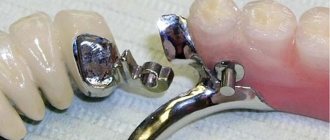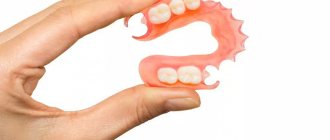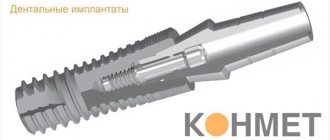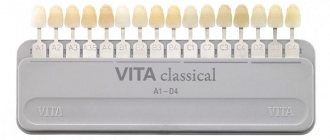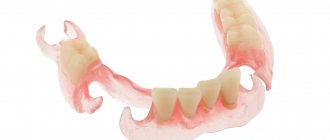Reversible reactions to the installation of prostheses
A denture is a foreign structure for tissues, so immediately after its installation the stage of adaptation begins.
It can be characterized by one or more primary reactions:
- Copious secretion of saliva. The oral cavity can recognize the new structure as food, which leads to activity of the salivary glands and increased secretion of gastric juice.
- The urge to vomit. This is the same natural response to a foreign body in the mouth; the urge goes away on its own after some time in most cases. However, dental practice also knows other cases - in some patients the gag reflex does not go away and is an obstacle to the installation of dentures in contact with the palate. In this case, the doctor will suggest other methods of prosthetics.
- Discomfort when chewing. More often it is observed when installing removable dentures, since in this case there are some features of the distribution of the chewing load. It also goes away after some time.
- Speech defects. Sometimes the components of the prosthesis interfere with the tongue, which leads to impaired articulation - it may be difficult for the wearer of the prosthesis to pronounce some words normally. Diction returns to normal after some time, as the tissues get used to the design.
- Changes in taste perception. Taste sensations involve not only the tongue - there are receptors in other parts of the oral mucosa. The sense of taste of food may be lost or dulled if the denture or part of it covers some areas of the mucous membrane.
In order to understand how to get used to removable dentures or fixed structures, you need to know whether this process has normal time limits.
Talk out loud more
Without teeth, the tongue in the oral cavity is much more spacious, so after the appearance of a prosthesis in it, it becomes more difficult for a person to pronounce many sounds. To quickly restore diction:
- try to talk as much as possible, read aloud, loudly and in a whisper;
- practice pronunciation by repeatedly repeating words with sounds that are difficult for you, for example s, zh, r;
- say tongue twisters repeatedly several times a day;
- do articulatory gymnastics.
Such training will help you quickly learn to speak clearly with a removable denture.
How long does it take to get used to dentures?
According to experts, orthopedic dentists and implantologists, adaptation to fixed structures is much easier. To answer the question of what period of adaptation is considered normal, it is necessary to take into account several factors: the characteristics of the oral cavity, the absence/presence of dental diseases and pathologies, the age of the patient, and the type of design. The question of how to quickly get used to dentures is rarely asked by patients who have had a crown or prosthesis installed on a pin, as well as an implant.
Even if several artificial structures appear in the oral cavity, adaptation to them occurs in a matter of days. It will take a little more time to get used to the so-called “bridges” - bridge-like prostheses.
The longest period of adaptation belongs to removable structures - dentures made of acrylic or nylon, clasp dentures containing metal. Here, the adaptation period consists of several conditions. How long it takes to get used to dentures depends on the following factors:
- product size;
- way of distributing the load during chewing;
- method of fixing the structure in the oral cavity;
- individual characteristics of the structure of the oral cavity, reactions to a foreign body.
How to quickly get used to removable dentures? Most experts are unanimous in their opinion - in the first month after installation of the structure, you do not need to remove it at night, this way you can reduce the adaptation period of the tissues. However, we must not forget about hygiene - the prosthesis must be regularly cleaned of plaque. To speed up addiction, you can use other advice from doctors.
What are the advantages of the design?
Metal-ceramic dental bridges have important advantages, due to which they are chosen by the vast majority of orthopedic dentists’ patients. Let's take a closer look at the positive characteristics:
- high aesthetics combined with a relatively low cost: this is the main advantage of a metal-ceramic bridge, which often becomes the “factor of choice” for the patient,
- fast production,
- Possibility of installation on both natural teeth and dental implants,
- quick adaptation and easy care.
Only until 30.09 South Korean implant Osstem - 19,900 rubles.
Hurry up to sign up for a free consultation and lock in promotional prices.
Call now or request a call
Opening hours: 24 hours a day - seven days a week
How to properly get used to dentures:
- Limit the consumption of solid foods in the first 4-5 weeks of wearing a prosthesis: nuts and tough meat, apples, carrots - if the discomfort is too strong, it is better to avoid such foods for a while. If you feel pain when eating soft foods, it is better to cut the food into small pieces. However, you should smoothly switch to a normal diet - nevertheless, the chewing load largely determines the adaptation process, and you should not switch exclusively to liquid food.
- Regular drinking water will help you cope with increased salivation or, on the contrary, dry mouth: you should drink it in small sips throughout the day. Therefore, make sure that you always have a bottle of clean, still water with you.
- In the question of how to properly get used to removable dentures, gum massage is very important - this improves blood supply to the tissues, speeds up healing and shortens the adaptation period. It must be done gently and carefully.
- In order to avoid the gag reflex, try following these recommendations:
- breathe deeply through your nose;
- use refreshing sugar-free candies;
- rinse your mouth with a solution of water and salt;
- Don't forget to clean your denture and pay attention to hygiene.
- For normal diction, repeat the following exercises:
- read aloud often - quietly and at a slow pace;
- increase the volume as you master speech;
- pronounce consonant sounds especially carefully;
- practice pronouncing tongue twisters.
- When it comes to getting used to fixed dentures and removable structures, it is very important to avoid sticky foods - this can lead to the structure breaking and the need to adapt to it again after repair or making a new one.
- Do not forget about hygiene procedures, as well as the use of fixation products recommended by your doctor - many of them not only serve as a way to secure the structure, but also contain components to prevent inflammation and other consequences.
Speech will be restored within 2–3 weeks.
In general, one month is usually enough for complete adaptation to a removable denture. However, if the addiction takes longer, you should pay attention to possible reasons:
- poor fixation - incorrect installation of the prosthesis in the oral cavity, use of an inappropriate means for fastening;
- jaw atrophy - a change in its structure;
- individual features of the jaw structure
In order to rule out serious causes, you need to consult a doctor. This especially applies to cases of installation of clasp dentures. It is difficult to adjust the position of the structure on your own - this can lead to breakdown. Therefore, it is important to visit a doctor - preferably the one who performed the installation.
Types of bridge structures
Metal-ceramic bridges are only permanent (there are no temporary ones). These are permanent structures, i.e. The dentist fixes them, but the patient cannot (and should not) remove them. Crowns are usually attached to special cement, and when installed on implants, they can be fixed with small screws.
For a traditional bridge (metal-ceramic or any other), at least 1 abutment tooth is required on both sides of the empty space. But there are also cantilever bridges, which are fixed on 1-2 supports only on one side of the empty area. However, they often cause dislocation of the supporting tooth, so they are not recommended for installation. Adhesive prostheses, known as Maryland (Bonded) Bridge, are not made from metal ceramics.
There are also 2 methods of processing the lower part of supporting metal-ceramic crowns. In the classic version, a thin strip of metal remains under the gum, not covered with ceramics. But there is an even more “advanced” option - crowns on the shoulder mass, when the edges of the crowns in the area of contact with the gum and tooth stump are covered with a layer of ceramics. This eliminates the risk of allergies and does not cause “blueness” of the gums.
Features of product repair
Is it possible to repair a dental bridge made of metal ceramics? It is possible, but only if, for example, part of the ceramic coating has chipped - then it is built up with new ceramics or composite. If the metal frame is cracked or falls apart, then even soldering will not help, because... the structure will soon break again at a “weak” point.
“I wore a metal-ceramic bridge without problems for a couple of years. But one day after eating I noticed that a small piece of ceramic had fallen off. I was all worried while I was waiting for an appointment with my dentist. But the doctor repaired this damaged crown very well, it looked perfect. But I was warned not to chew anything hard on this side, because it could break off even harder.”
Lyudmila A., review from the site irecommend.ru
What is known about the disadvantages and complications after treatment
The disadvantages of a metal-ceramic dental bridge include a decrease in the aesthetics of the gums over time - this is especially noticeable on the front teeth. If simple metal-ceramic crowns are used (not with shoulder material), then due to constant contact with the metal, the gums become “bluish” in color. Also, the gums can peel off from the tooth and “go” up or down. In patients with a gummy smile - when part of the gum is exposed when smiling, this defect is most noticeable.
Therefore, it is recommended to install a classic metal-ceramic bridge on chewing teeth, and on the front teeth it is better to install ceramics without metal in the base. Or choose a metal-ceramic bridge on implants, but with the addition of a small section of acrylic gum.
Read on the topic: what is gingival contour correction during prosthetics and who may need this operation?
Another disadvantage of a bridge design based on your own teeth is that it does not protect against bone atrophy under the intermediate crowns. After all, the roots are no longer there, i.e. and the bone does not receive the same load - therefore, metabolic processes in this area stop, and the bone tissue decreases in size. Accordingly, the gums also recede, incl. near the supporting teeth. There is a risk of cervical caries. There is also a gap between the bridge and the gum, where food debris gets clogged and plaque accumulates. As a result, the bridge may begin to wobble or even fall out.
High-quality veneering ceramics – manufacturers
Today, there are many manufacturers of ceramic masses for lining metal prosthetic frames. Let's look at those brands that have been delivering high-quality products for a long time:
- IPS Classic, IPS d.SIGN and IPS Style from Ivoclar Vivadent: the manufacturer offers a wide range of ceramic compounds for application to metal - these are classic compounds and modern ones with fluorapatite (glass ceramics) and oxyapatite. Allows you to create restorations that are indistinguishable from natural teeth,
- Super Porcelain EX-3 from Kuraray Noritake: the material conveys almost natural translucency and shade transitions from the cutting edge of the crowns to the base,
- Duceram plus and Duceram kiss from Dentsply Sirona: easy-to-use and versatile formulations with excellent aesthetics and high strength,
- VMK Master from VITA Zahnfabrik: universal material for frames made of base and precious metals, shrinks minimally during manufacturing.
